Results
-
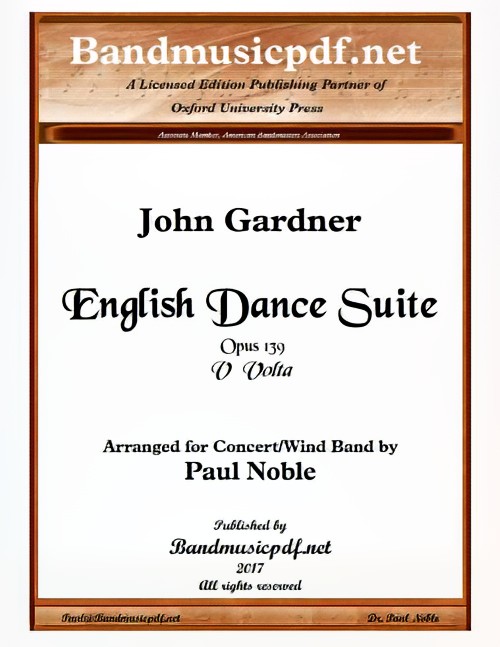 £75.00
£75.00English Dance Suite - V. Volta (Concert Band - Score and Parts) - Gardner, John - Noble, Paul
Arranged for the modern Concert/Wind Band, scored for three trumpets, reasonable doubling of parts where the original musical effect is not altered so that players can have a more responsible and enjoyable experience, more legible parts with less doubling on one staff, etc. The piece is offered either as a complete suite of seven movements, and also as seven individual movements which may be purchased independently. The English Dance Suite was originally composed by John Gardner for Wind Band, and has been re-set for the modern Concert Band instrumentation. Both the original version, edited and type-set by Paul Noble, and this arrangement are first editions now available for purchase to bands around the world. The set of seven Renaissance dances depict John Gardner's love of Scottish music, the Renaissance heritage, and some of his own mischievous approach to music. The first movement, Chacony on a Golden Theme, reminiscent of the Allegro movement of Purcell's Golden Sonata, is much used as a vehicle for variation on a repeated short harmonic progression, often involving a fairly short repetitive bass-line which offered a compositional outline for variation, decoration, figuration and melodic invention. In this it closely resembles the passacaglia. The Alman originated in the 16th century as a duple metere dance of moderate tempo, already considered very old, with a characteristic double-knocking upbeat of one or occasionally three sixteenth notes. It appears to have derived from a German dance but no identifiable dance and no German dance instructions from this era survive. The Hornpipe, usually in 3/2 dance rhythm, is an Irish, Scottish and English dance. It is done in hard shoes, which are used to help keep track of how the dancer keeps in time. There are two variations of the hornpipe dance: fast and slow. Usually, more experienced dancers will do the slow hornpipe but younger dancers will start out with the fast hornpipe and then switch in later years. The Corranto is a 16th-century court dance characterized by short advances and retreats, in quick triple time. The Volta (Italian: the turn or turning) is an anglicised name from the later Renaissance. Its main figure consisted of a turn and lift in a sort of closed position. The Pavan is a slow processional dance common in Europe during the 16th century. The Reel, indigenous to Scotland, consists largely of quaver (eighth note) movement with an accent on the first and third beats of the bar.
Estimated dispatch 7-14 working days
-
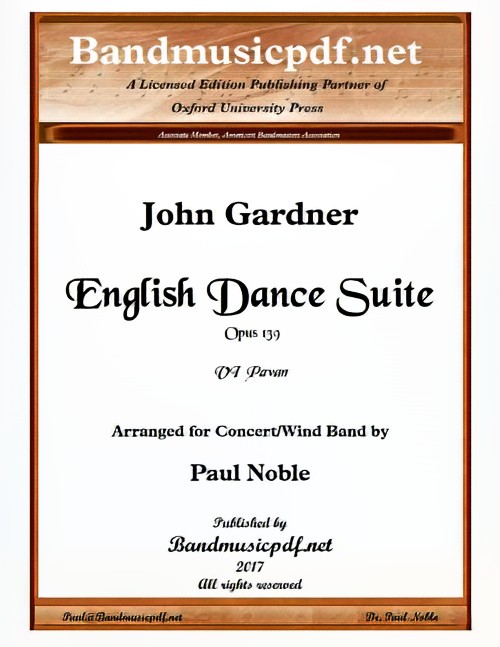 £75.00
£75.00English Dance Suite - VI. Pavan (Concert Band - Score and Parts) - Gardner, John - Noble, Paul
Arranged for the modern Concert/Wind Band, scored for three trumpets, reasonable doubling of parts where the original musical effect is not altered so that players can have a more responsible and enjoyable experience, more legible parts with less doubling on one staff, etc. The piece is offered either as a complete suite of seven movements, and also as seven individual movements which may be purchased independently. The English Dance Suite was originally composed by John Gardner for Wind Band, and has been re-set for the modern Concert Band instrumentation. Both the original version, edited and type-set by Paul Noble, and this arrangement are first editions now available for purchase to bands around the world. The set of seven Renaissance dances depict John Gardner's love of Scottish music, the Renaissance heritage, and some of his own mischievous approach to music. The first movement, Chacony on a Golden Theme, reminiscent of the Allegro movement of Purcell's Golden Sonata, is much used as a vehicle for variation on a repeated short harmonic progression, often involving a fairly short repetitive bass-line which offered a compositional outline for variation, decoration, figuration and melodic invention. In this it closely resembles the passacaglia. The Alman originated in the 16th century as a duple metere dance of moderate tempo, already considered very old, with a characteristic double-knocking upbeat of one or occasionally three sixteenth notes. It appears to have derived from a German dance but no identifiable dance and no German dance instructions from this era survive. The Hornpipe, usually in 3/2 dance rhythm, is an Irish, Scottish and English dance. It is done in hard shoes, which are used to help keep track of how the dancer keeps in time. There are two variations of the hornpipe dance: fast and slow. Usually, more experienced dancers will do the slow hornpipe but younger dancers will start out with the fast hornpipe and then switch in later years. The Corranto is a 16th-century court dance characterized by short advances and retreats, in quick triple time. The Volta (Italian: the turn or turning) is an anglicised name from the later Renaissance. Its main figure consisted of a turn and lift in a sort of closed position. The Pavan is a slow processional dance common in Europe during the 16th century. The Reel, indigenous to Scotland, consists largely of quaver (eighth note) movement with an accent on the first and third beats of the bar.
Estimated dispatch 7-14 working days
-
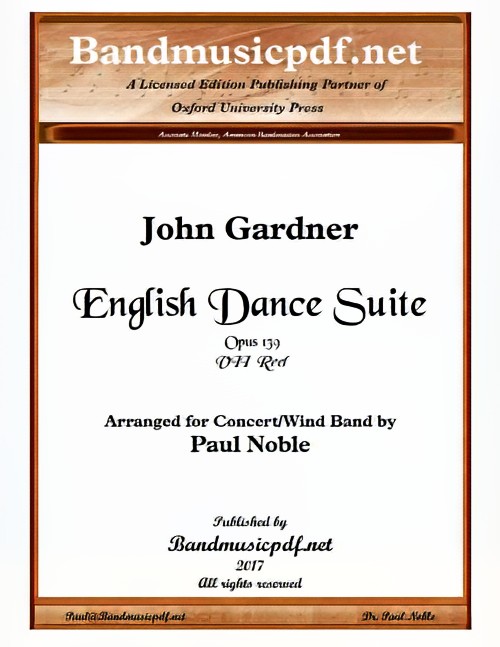 £125.00
£125.00English Dance Suite - VII. Reel (Concert Band - Score and Parts) - Gardner, John - Noble, Paul
Arranged for the modern Concert/Wind Band, scored for three trumpets, reasonable doubling of parts where the original musical effect is not altered so that players can have a more responsible and enjoyable experience, more legible parts with less doubling on one staff, etc. The piece is offered either as a complete suite of seven movements, and also as seven individual movements which may be purchased independently. The English Dance Suite was originally composed by John Gardner for Wind Band, and has been re-set for the modern Concert Band instrumentation. Both the original version, edited and type-set by Paul Noble, and this arrangement are first editions now available for purchase to bands around the world. The set of seven Renaissance dances depict John Gardner's love of Scottish music, the Renaissance heritage, and some of his own mischievous approach to music. The first movement, Chacony on a Golden Theme, reminiscent of the Allegro movement of Purcell's Golden Sonata, is much used as a vehicle for variation on a repeated short harmonic progression, often involving a fairly short repetitive bass-line which offered a compositional outline for variation, decoration, figuration and melodic invention. In this it closely resembles the passacaglia. The Alman originated in the 16th century as a duple metere dance of moderate tempo, already considered very old, with a characteristic double-knocking upbeat of one or occasionally three sixteenth notes. It appears to have derived from a German dance but no identifiable dance and no German dance instructions from this era survive. The Hornpipe, usually in 3/2 dance rhythm, is an Irish, Scottish and English dance. It is done in hard shoes, which are used to help keep track of how the dancer keeps in time. There are two variations of the hornpipe dance: fast and slow. Usually, more experienced dancers will do the slow hornpipe but younger dancers will start out with the fast hornpipe and then switch in later years. The Corranto is a 16th-century court dance characterized by short advances and retreats, in quick triple time. The Volta (Italian: the turn or turning) is an anglicised name from the later Renaissance. Its main figure consisted of a turn and lift in a sort of closed position. The Pavan is a slow processional dance common in Europe during the 16th century. The Reel, indigenous to Scotland, consists largely of quaver (eighth note) movement with an accent on the first and third beats of the bar.
Estimated dispatch 7-14 working days
-
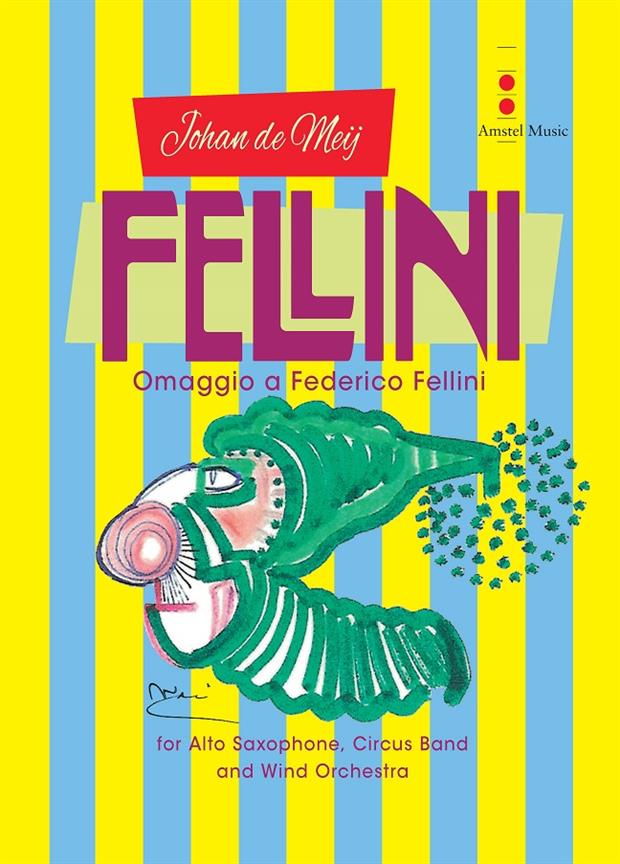 £366.00
£366.00Fellini (Omaggio a Federico Fellini) (Alto Saxophone with Concert Band - Score and Parts) - De Meij, Johan
Fellini takes the listener into the surrealistic and dreamy world of legendary Italian filmmaker Federico Fellini. The alto saxophone soloist - being the personification of a clown - and the off stage circus band add a unique theatrical element to the work.Duration: 23.00
Estimated dispatch 7-14 working days
-
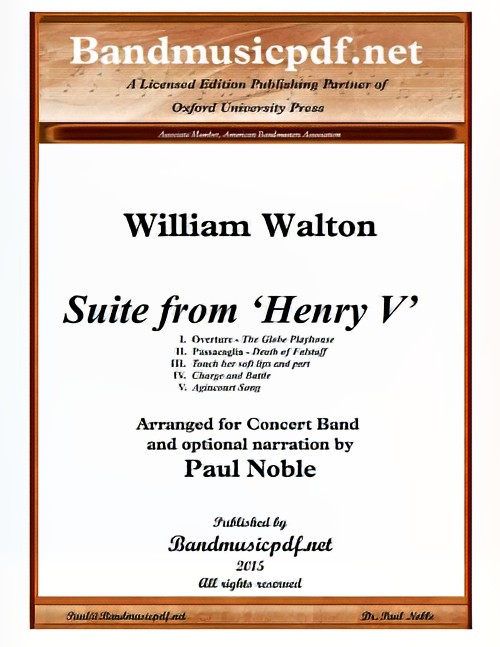 £450.00
£450.00Henry V, Suite from (Concert Band with Optional Narrator - Score and Parts) - Walton, William - Noble, Paul
The Suite from Henry V is an arrangement for Concert Band and optional narrator, adapted from the 1963 orchestral arrangement of William Walton's musical score from the 1944 film Henry V. The suite, originally arranged for orchestra by Muir Mathieson, is in five movements, and occupies a very significant role in the history of music and of Shakespearean studies. Performances exist in a variety of formats because the adaptation of the narration to a film suite is subject to choice. To be chronologically correct, the order of movements from the original suite has been altered to adhere to the narration of the play. And the choice of speeches has required considerable research by classicists who are familiar with the writings of Shakespeare. It has been the endeavour of this arranger to research and present this suite in as authentic a manner as possible, understanding that it might well become the standard by which Concert Bands of the future will adapt and present this music. The arranger is indebted to Anna Warren, a resident of Twickenham and a graduate in Modern Languages (French and Italian) and History from the University of Bristol and a postgraduate from The Institute of Education, the University of London, for her knowledge and insight into the formation of the narration.
Estimated dispatch 7-14 working days
-
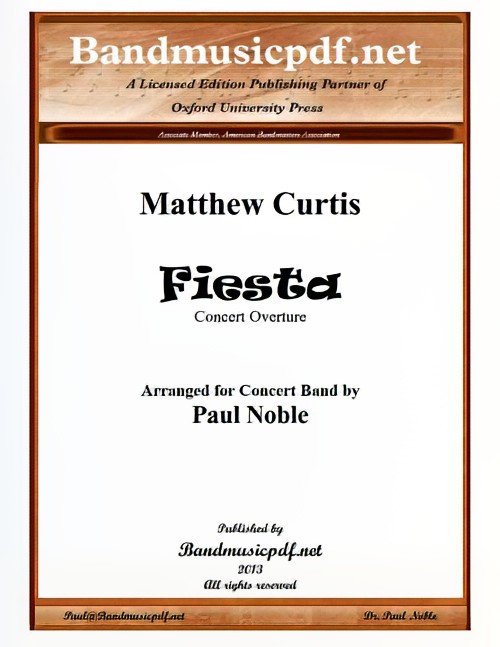 £110.00
£110.00Fiesta (Concert Band - Score and Parts) - Curtis, Matthew - Noble, Paul
Despite its Spanish title, the concert overture Fiesta is really Italian, recalling a festival that I saw several times as a child in the late 1960s while holidaying in a village at the southern tip of the bay of Naples. The date is August 15, the occasion the feast of the Assumption of the Virgin Mary, celebrated with colourful processions and ritual (some, one imagines, pre-Christian in origin), all rounded off with brass bands and home-made fireworks. - Matthew Curtis. Fiesta was originally written for the orchestra of St. Paul's School in London, It has had performances in London's Queen Elizabeth Hall and the Royal Festival Hall where it opened a live broadcast concert in the BBC's International Festival of Light Music, and has made intermittent appearances on the radio ever since. This arrangement for Wind Band will make an excellent festival opener for accomplished bands and is a sure crowd pleaser with its dynamic flare and energy.
Estimated dispatch 7-14 working days
-
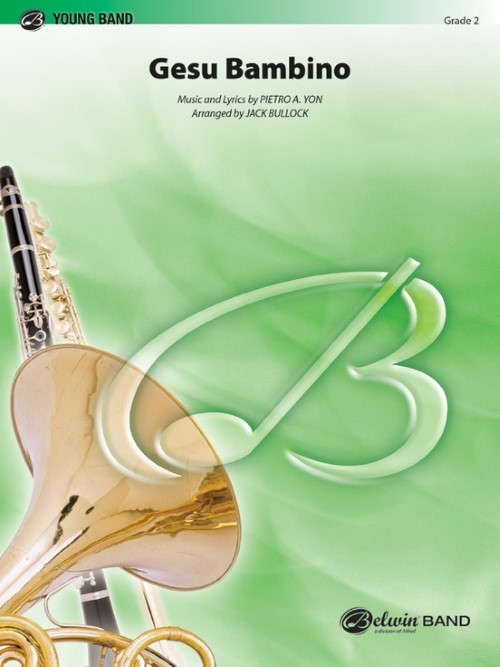 £58.50
£58.50Gesu Bambino (Concert Band - Score and Parts) - Yon, Pietro A. - Bullock, Jack
This charming Italian carol will not only be well received on any Christmas programme, but also reinforce triple-meter and DS al Coda form, phrasing, and ensemble balance. An endearing musical choice!Duration: 2:30
Estimated dispatch 7-14 working days
-
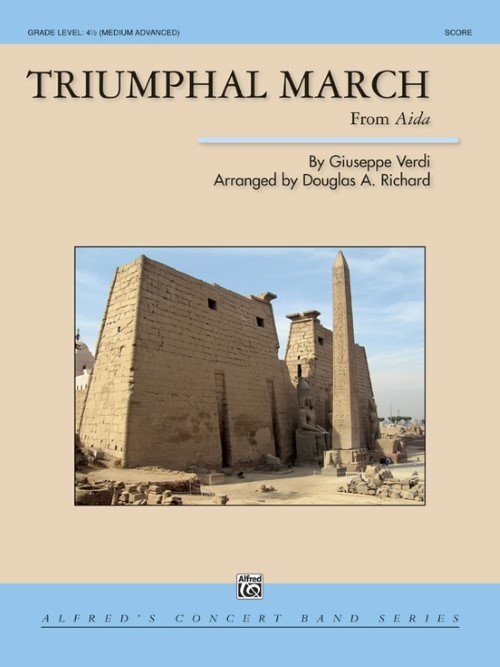 £82.95
£82.95Triumphal March (from Aida) (Concert Band - Score and Parts) - Verdi, Giuseppe - Richard, Douglas
There is a saying that "the test of great music is that it stands the test of time." While there have been many triumphal marches written by great composers, few are as well-known as this powerful and exuberant march from Act II of Giuseppe Verdi's 1871 grand opera, Aida. This arrangement is orchestrated to showcase the richness and capabilities of the contemporary wind band and is based on the early 20th Century setting by the famous Italian bandmaster and composer Giuseppe Creatore. Duration: 5:15
Estimated dispatch 7-14 working days
-
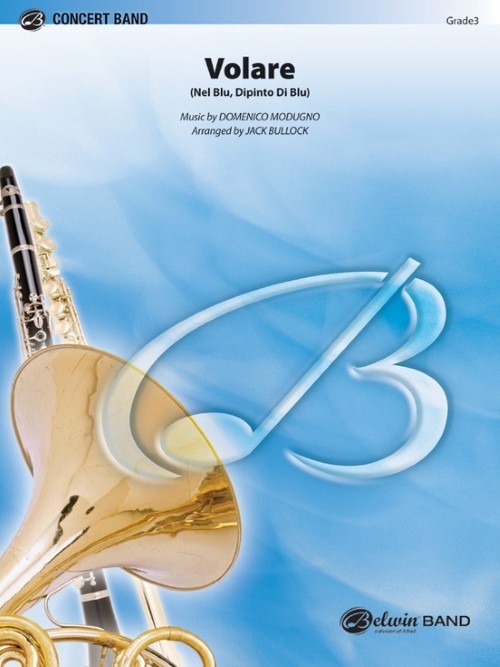 £76.95
£76.95Volare (Nel Blu, dipinto Di Blu) (Concert Band - Score and Parts) - Modugno, Domenico - Bullock, Jack
Literally translated from the Italian "to fly," Volare has been a widely recognised energetic ballad since its creation in the mid-50s. Recorded in widely diverse styles by Dean Martin, Frank Sinatra, and Bobby Rydell, among others. Jack Bullock's concert band scoring is certain to have them singing in the aisles. Woo-oh-oh-oh!Duration: 3.15
Estimated dispatch 7-14 working days
-
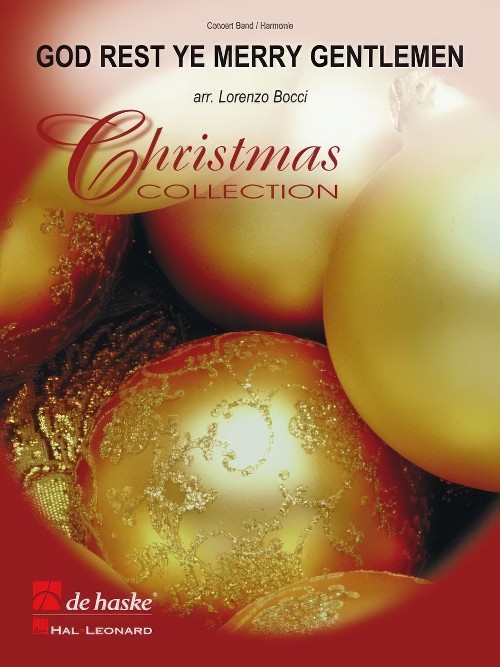 £74.99
£74.99God Rest Ye Merry, Gentlemen (Concert Band - Score and Parts) - Bocci, Lorenzo
God Rest Ye Merry Gentlemen appeared in print for the first time in William Sandy's Christmas Carols Ancient and Modern in 1833, although it was believed to have been written many years earlier. Today, God Rest Ye Merry, Gentlemen is one of the most loved and popular English Christmas songs of all time. Italian composer and arranger Lorenzo Bocci fell in love with the delightful melody and created an arrangement that will be perfect at any Christmas concert or event.Duration: 2:20
Estimated dispatch 7-14 working days
